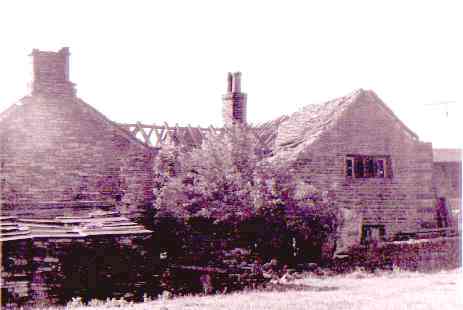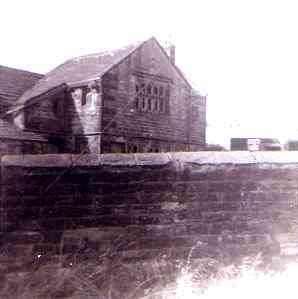RAMBLES ROUND JUDY WOODS
Take a bus from Bradford or Halifax to the Sportsman Inn, Buttershaw, (or alternately to the Prince of Orange, Shelf, if the direct footpath to Riding Hill Bridge is favoured).
The Sportsman was formerly known as the Furnace Inn, and derived its name from the nearby Shelf Ironworks which was founded in 1786, and which manufactured iron bridges, one of which still survives at Newlay. The Ironworks was sited behind the former St. Michael's Vicarage on Carr House Road, which was originally the iron master's house and offices. The old engine house, now a private house, survives and until a few years ago the old furnace could still be seen, before the site was bulldozed to make way for housing development. The cottages of New Fold and Beck Hill were built to house the iron workers, and make up the oldest part of the area known as 'Old Buttershaw'. Shelf Ironworks was bought by the Low Moor Iron Company in 1824 and was closed down in 1849, after which the site lay derelict. In 1798 the output of Shelf Ironworks was 3,442 tons. From the Inn we cross the main Halifax road to the top of
MANORLEY LANE
The low stone building on the right, at the top of Manorley Lane, (now a car showroom) was the original Beck Hill Working Men's Club. Mentioned by Parker in his 'Illustrated Rambles from Hipperholme to Tong' this must be one of the oldest W.M.Cs in Bradford. When the club was moved to its present, modern premises further down the road, the old club became a betting shop, and after a short period of dereliction was turned to its present use. The present club, which was once large and thriving, got into difficulties and its concert room was turned into a shooting gallery for a local rifle club.
Continuing down Manorley Lane, Gullet's (Mill House) Farm is reached on the left. Beyond the lane descends steeply to the beck, which it crosses by an attractive stone bridge, close by Manor Vale Bungalow. This is known as
RIDING HILL BRIDGE
Riding Hill Bridge is a pleasant place to stop awhile, while we make a few observations on the little stream that runs below our feet.
Riding Hill Bridge stands on the boundary between North Bierley and Shelf, Bradford and Calderdale. The stream, in fact, marks the Metropolitan Boundary for most of its course. Rising just below Queensbury Golf Club, not far from Shelf Moor, it is, for the first part of its journey known as the Blackshaw Beck. Running past Westwood Hospital it passes under Cooper Lane, and, still marking the boundary, passes the western edge of Buttershaw Estate. The beck next passes under Carr House Road and the main Halifax road in rapid succession. From here it meanders peacefully through meadows until it finally flows beneath us here at Riding Hill Bridge, at which point it becomes the Royds Hall Beck, a name it keeps for the duration of its journey through the woods.
On the far side of the bridge Riding Hill rises steeply up the far slope. A footpath to the right (up steps and very overgrown) passes by Manor Vale Bungalow to emerge close by St. Michael's Church, Shelf. If one wishes to miss Manorley Lane from the itinery this route provides perhaps the most attractive access to the woods. (Bus to the Prince of Orange, Cooper Lane. Sign opposite 'to Riding Hill Bridge 0.3 km')
Beyond the bridge, a short distance up Riding Hill, a stile on the left gives access to woodland. This route leads directly down the woods, emerging on the 'Snoddy' from which point a number of routes may be selected.
Continuing up Riding Hill, with vetch, harebells and honeysuckle along the wayside, we pass Riding Hill Cottages to emerge at the juction with Green Lane. Turn left, on a track marked 'no through road'. On the right may be seen the gaunt, sad ruin of
HIGH BENTLEY.
(NOTE: since time of writing both High and Low Bentley have been extensively restored and rebuilt.)

HIGH BENTLEY IN ITS FORMER RUINOUS STATE
High Bentley is dated 1661, although parts of the house are most definitely older. It had been derelict for years, the property of a building contractor who allowed it to fall down, but happily this listed building has finally found an owner who appreciates its significance, and the whole edifice has now being patiently restored.
High Bentley is a fascinating house. The unusual window at the centre of the block (seen from Green Lane) fronts a room that was once known as the 'little chapel'. In 1876 it was occupied by a Mr. Tempest. As to the religion of those who once used the 'little chapel' we can only guess. In the eighteenth century it was used by Presbyterians, and later still by the promoters of the now-demolished Witchfield Chapel Shelf. It is the chapels' earlier usage we are uncertain of. A vague tradition asserts that it was used by Catholics, but more likely it was a meeting house for seventeenth century dissenters, who were numerous in this neighbourhood. The well known local dissenting preacher, Oliver Heywood refers in his diary to the house of a Mrs. Wright, where, says Heywood, '.... we had most solemn and numerous meetings ... over a hundred persons ... in a more private place than ever before where I can sing and speak as loud as I please without fear of being overheard. ...'. On the completion of dwelling houses dedication services were held during which family initials were chiselled over doors. The High Bentley initials 'R.W. I.W. lend weight to the 'Mrs Wright' theory.
Once upon a time High Bentley possessed a magnificent gallery loft and an ornate fireplace bearing a coat of arms on the chimney breast, with the royal motto 'Dieu et mon Droit' flanked by supporting figures with the emblems of Ireland and Scotland. The whole device was capped by the initials C.R. and dated 1661. On the mantelpiece were also the previously mentioned initials R.W. I.W.
A short distance down the road is
LOW BENTLEY.
This was also derelict for a long time, but has been restored and is now a beautiful home. The house was built in 1600 and bears the initials W.C. T.C. Further yet down the road, also restored is Jake Royd Farm. This bears the date 1680 and the initials G.B. I.B. It is surprising to find so many of these substantial seventeenth century houses so close together, but back in those days when improved quarrying techniques were giving rise to a boom in facing timber framed houses with stone, the humble back lane of Riding Hill would have been a major highway.

LOW BENTLEY IN ITS FORMER RUINOUS STATE
Next Page





copyright © Jim Jarratt 2002











